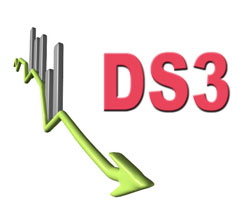Companies seeking to increase bandwidth often consider DS3 bandwidth service. This article explains DS3 and other technologies that provide similar mid-level bandwidth.
 DS3, or Digital Signal 3, is a standardized telecom service that uses TDM (Time-Division Multiplexing) technology. To clarify, the fundamental unit is DS0 at 64 Kbps, representing a single digitized phone call. DS1, bundling 24 DS0 channels, operates at 1.5 Mbps and is commonly known as a T1 line. DS3, the next level, delivers 45 Mbps, combining 672 DS0 channels or 28 T1 lines. When you order a T3 line, you receive a DS3 implementation.
DS3, or Digital Signal 3, is a standardized telecom service that uses TDM (Time-Division Multiplexing) technology. To clarify, the fundamental unit is DS0 at 64 Kbps, representing a single digitized phone call. DS1, bundling 24 DS0 channels, operates at 1.5 Mbps and is commonly known as a T1 line. DS3, the next level, delivers 45 Mbps, combining 672 DS0 channels or 28 T1 lines. When you order a T3 line, you receive a DS3 implementation.
Although DS1 and DS3 were initially designed for telephone companies, they are now predominantly used for data packet transmission, including private point-to-point lines and dedicated internet connections. In such applications, the entire bandwidth transports data packets.
A full DS3 circuit offers 45 Mbps bandwidth for both uploads and downloads, making it a popular and widely available service. You need a router interface card with a DS3 termination to use this service. Two 75-ohm coaxial cables, similar to those used for cable TV but specifically Bellcore 734 or 735, connect to the router interface card using BNC connectors. One cable handles transmission (upload), and the other handles reception (download). Multiple cable pairs may be present if the router supports multiple DS3 connections.
While you might envision coaxial cables running from your building to the telephone central office, similar to T1 and multi-line telephone services, they are typically used for short distances. In practice, DS3 bandwidth is usually delivered via SONET fiber optic cable, demultiplexed, and delivered to your location.
DS3 bandwidth, at 45 Mbps, might exceed your requirements, considering the significant difference from a 1.5 Mbps T1 line. Companies often scale their bandwidth by combining multiple T1 lines to achieve double or triple the individual line bandwidth, reaching up to 10 or 12 Mbps. But what if you need 20 or 30 Mbps?
Fractional DS3 service offers a solution. While a full DS3 interface is installed, the bandwidth is limited to your specified fraction, such as 15, 20, or 30 Mbps. This option might save money but is not always available in all locations or from all providers, making a full DS3 connection a more practical choice.
Alternative technologies in this bandwidth range compete with fractional and full DS3. Ethernet over Copper, a highly scalable service, rivals T1 at speeds of 1.5, 2, and 3 Mbps and offers options for 10, 15, 20, 25, 30, 50, and even 100 Mbps. This allows for closer alignment between your budget and required bandwidth. Although not as widely available, Ethernet over Copper often proves more cost-effective than T1 or DS3 for comparable bandwidth.
Fixed wireless bandwidth services, often delivering DS3 bandwidth over Ethernet protocol, are another option found in major business districts. This is often desirable since you’ll likely connect to an Ethernet-based LAN.
Finally, business-class Cable broadband presents a cost-effective alternative to DS3. While a shared service with fluctuating bandwidth depending on user activity, it can deliver downloads up to 50 or 100 Mbps and uploads of 5 or 10 Mbps at a price comparable to a T1 line. However, availability depends on existing cable infrastructure at your location, as installation costs can be prohibitive otherwise.
If your business needs higher bandwidth due to growth, increased computerization, or migration to cloud services, explore the pricing and availability of DS3 and fractional DS3 services, along with other bandwidth services that may meet your needs.

